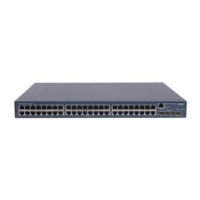3-7
Note that if you configure not to authenticate the users, the command level available to users logging in
to a switch depends on both the authentication-mode none command and the user privilege level
level command, as listed in
Table 3-4.
Table 3-4 Determine the command level when users logging in to switches are not authenticated
Scenario
Authentication
mode
User type Command
Command level
The user privilege level level
command not executed
Level 0
None
(authentication-mod
e none)
VTY users
The user privilege level level
command already executed
Determined by
the level
argument
Configuration Example
Network requirements
Assume that you are a level 3 AUX user and want to perform the following configuration for Telnet users
logging in to VTY 0:
z Do not authenticate users logging in to VTY 0.
z Commands of level 2 are available to users logging in to VTY 0.
z Telnet protocol is supported.
z The screen can contain up to 30 lines.
z The history command buffer can contain up to 20 commands.
z The timeout time of VTY 0 is 6 minutes.
Network diagram
Figure 3-4 Network diagram for Telnet configuration (with the authentication mode being none)
Configuration procedure
# Enter system view, and enable the Telnet service.
<Sysname> system-view
[Sysname] telnet server enable
# Enter VTY 0 user interface view.
[Sysname] user-interface vty 0
# Configure not to authenticate Telnet users logging in to VTY 0.
[Sysname-ui-vty0] authentication-mode none
# Specify commands of level 2 are available to users logging in to VTY 0.
[Sysname-ui-vty0] user privilege level 2

